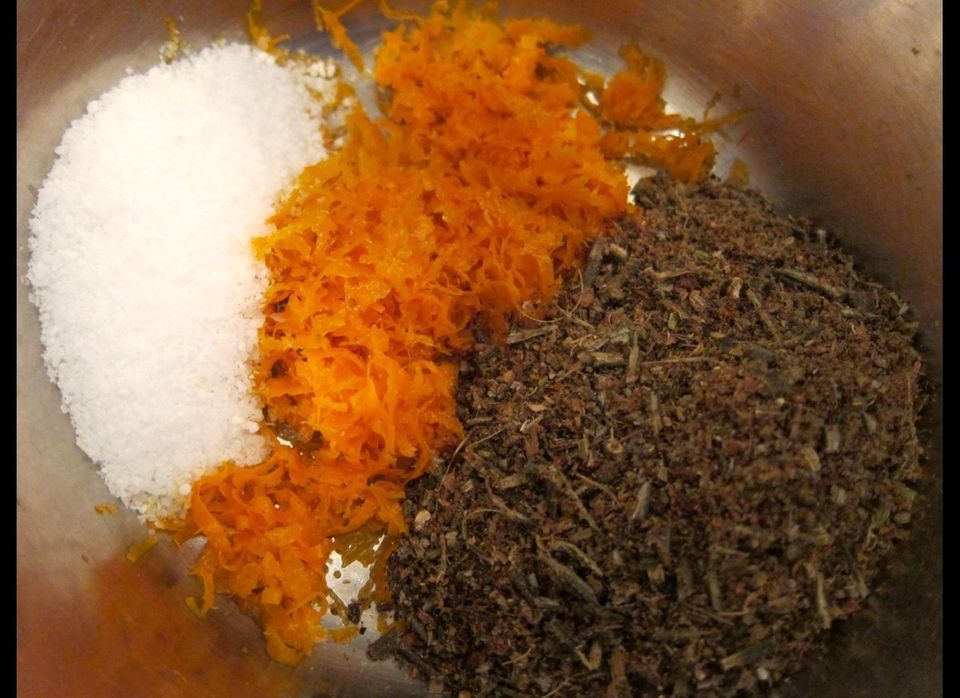One of the guests at a dinner party scuttled by the recent snowstorm was going to be the man who introduced the Negroni to our short list of favorite drinks. It seemed to me that its flavors - gin, Campari and Italian vermouth, plus a slice of orange as a garnish - lent themselves to sauce-making. The orange slice led to duck, which, for good or (usually) for ill, is so often served with that fruit. And it would be braised, not roasted, duck - legs - to yield a poultry-rich sauce, not just a warmed-up cocktail.
The Campari and sweet vermouth (I use Carpano Antica Formula, which is particularly fine) didn't present any problems: they would cook gently with the duck and lend their flavors to the dish. The gin, though, was a puzzle. Unlike, say, cognac, it wouldn't lay a foundation of flavor: it would just evaporate and leave behind the merest ghost of the aromatics it contained. So I decided to use some of those aromatics and skip the gin entirely: I'd make a seasoning rub built around juniper berries, one of the constants in gin manufacture.
A day ahead, I prepared eight moulard duck legs by trimming excess fat, removing the thigh bones and hacking off the ends of the drumstick bones (both for sauce-making and to make the legs smaller so they'd fit in a single pan). I sprinkled them generously with this rub: A good tablespoonful of juniper berries, plus smaller quantities of mace, caraway, coriander seed, anise and cinnamon, all ground in a spice grinder; finely minced rosemary; salt and black pepper; and the grated zest of two oranges. To make the legs even more compact, I rolled the thigh meat around where the bones used to be and tied them with kitchen twine. These went into the fridge, covered with plastic wrap, to take on the seasonings.
I had bought six of those legs as legs, but for the other two I'd bought a whole duck; the boneless breasts I froze for another meal, and I cut up the carcass and put it, with the leg bones and trimmings, in a heavy pot over medium heat until nicely browned. I poured off and saved most of the rendered fat and added the usual aromatic vegetables, which I cooked until beginning to brown. I deglazed the pan with white wine, added a squeeze of tomato paste, a little rosemary and parsley, and added chicken stock to generously cover (vegetable stock or water would have been okay). I simmered this sauce base for about an hour and a half, then strained it and left it to cool. Once it had chilled in the fridge, it was easy to remove the solidified fat from the surface.
The next day, I slowly browned the skin of the duck legs in a deepish 12-inch straight-sided sauté pan. This took a solid 20 minutes over medium-low heat and yielded a cup of fat, which I discarded (it was overcooked and wouldn't be useful for sautéing). I added 2/3 cup each of red Italian vermouth and Campari, 3 cups of the duck sauce base, the zest of one orange (removed in strips with a vegetable peeler), a few crushed juniper berries and some rosemary. And salt - enough to taste. The liquid should come about 2/3 of the way up the duck legs, and the quantity will depend on the geometry of your pan. I covered the duck with a circle of parchment paper, then with the pan lid, which I left ajar, and placed the pan into a preheated 350-degree F oven. It took about two hours for the duck to become truly tender - but start checking after an hour and a quarter.
I removed the duck to a dish to cool and strained and defatted the sauce, which I then transferred to a saucepan for adjustment. It needed more of everything: sauce base for quantity and vermouth, Campari and a teaspoonful of sherry vinegar for flavor. And salt and pepper, of course. At this point I made a slurry of Campari and cornstarch and stirred it bit by bit into the slowly boiling sauce to give it a bit of consistency, though not to thicken it too much.
Ten minutes before serving (this was the night after the cancelled dinner party with an entirely different cast of characters), I slowly browned and reheated one duck leg per person in a covered non-stick skillet, then turned the duck skin-side up and added an appropriate amount of sauce. Polenta was the best of accompaniments - made with plain water and without any cheese.
Okay, "duck," not "Negroni," was the first word that came to mind when we tasted this dish. But once the name had been uttered, the cocktail's bitterness, sweetness and aromatic complexity was easily recognizable. And even if it hadn't been, the seasoning rub and sauce could hardly have been better with the tender confit-like braised duck.
Luckily, there was leftover sauce, so the fate of those two duck breasts in the freezer has been determined.
